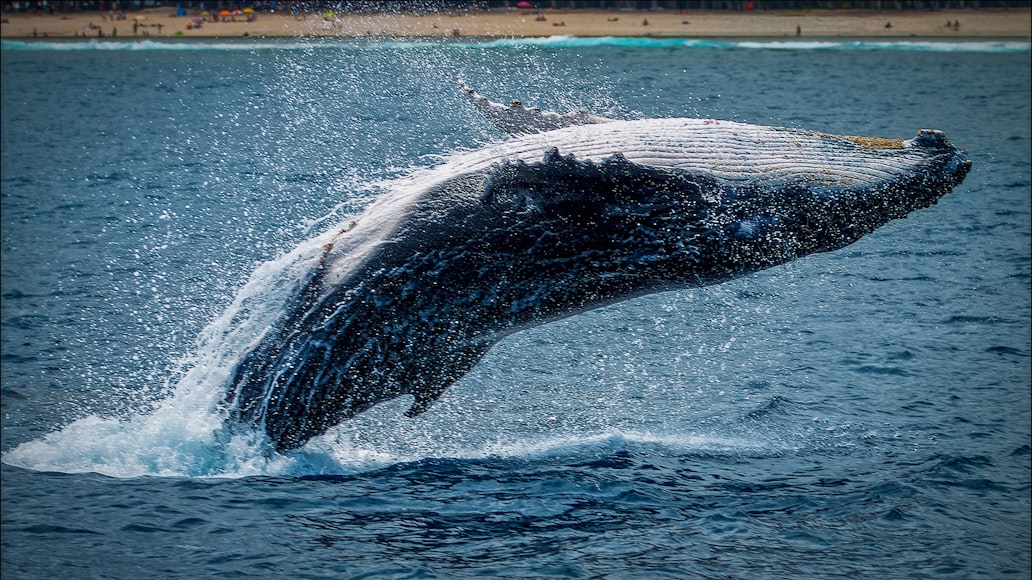Whales belong to the order Cetacea of mammals. They have streamlined and hairless bodies. Their forelimbs are modified into paddle-like flippers for swimming, and hind limbs are reduced and not visible Externally. They have external nares (blowholes) on the top of their skull.
Whales are facing danger in their existence to date. Many whale species are endangered. Whales have a long life span they do not reproduce very often. A Whale attains maturity at the age of 12 years and after that reproduces after 2 years; on average. So the slight change to their habitat can put whales at risk.
Threats to whales and their habitat are both direct and indirect. Direct Threats comprise hunting, whaling, entanglement in fishing gear, marine pollution, ship strikes, habitat loss due to coastal development, and deaths due to underwater sonar testing.
Indirect effects are climate change, decreased reproduction (due to prey depletion), bioaccumulation, coastal pollution, coastal construction, effects of noise pollution and boat traffic.
Commercial whaling in the nineteenth century put many whale species in danger of extinction. Whaling is the hunting of whales to get some products like oil and Baleen. Hunting in the 19th century for the extraction of whale oil and baleen was a tragic event that led some whale species to the verge of extinction. Whale oil was used in medicinal products and baleen was used for hair and brushes.
Habited degradation is associated with human activities that led to less suitable habitat for whales and other marine Species. The causes of habitat degradation are climate change, chemical pollution, noise pollution, the introduction of pathogens, ship traffic coastal constructions, and Ship strikes. All of these factors are leading to the gradual habitat loss for whales and other marine mammals.

Climate changes such as global warming can lead to the destruction or disturbance in the whales’ habitat. Global warming is a big cause of the melting of glaciers and ice caps it makes the flow of freshwater towards the Oceans and disturbs the saline level and salt concentration. This also disrupts thermocline circulation. Change in the temperature of sea water causes the whales to migrate.
Ship traffic and ship strikes can leadwhales injuries or death in coastal areas. No doubt the trade through ships is critical, but at the same time, it is a severe threat to marine life. They get entangled in fish gears, traps, pots, or gillnets. The gears are anchored in their bodies rendering them injured and sometimes dead.
Noise pollution from human activities like construction and other noise sources near the oceans and Sea can lead to critical problems for whales. Seismic surveys and military sonar activities also add to the marine noise pollution. This can harm whales by damaging their hearing, causing internal bleeding, disruption of normal behavior, and even death.
Contamination of the sea and oceans is a major risk to whale habitat and marine environment as a whole. Chemicals, Plastics, and oil through oil spillage; all of these are forms of ocean pollution. It has drastic effects on the whole marine ecosystem.
Certain chemicals such as Polychlorinated Biphenyls (PCBs) are unsafe for marine Species mainly Whales. These hazardous chemicals enter through food (prey) in their bodies and get stored there. This dangerous chemical can pass on from female whales to their newborn calves, and can be fatal for their progeny. Accumulation of heavy metals like Mercury in oceans is responsible for reproductive complications in several marine species.
Several NGOs and other Conservation organizations are struggling to conserve marine species. They are striving to make aware the residents of the climate changes causing their habitat degradation. We as individuals should use ozone-friendly products, encourage recycling, avoid the use of plastic bags and keep our environment safe for other living species on our planet.
References:
- Berta, Annalisa, Whales, dolphins, and porpoises: natural history and species guide (2015) SUSAN KELLY
- Clapham, Phillip; Young, Sharon; and Brownell, Robert L. Jr., “Baleen Whales: Conservation Issues and The Status Of The Most Endangered Populations” (1999). Publications, Agencies, and Staff of the U.S. Department of Commerce. 104
- Caroline Bingham,Whales and dolphins (2003) DK Publishinguni.
- Erich Hoyt,Marine Protected Areas for Whales,Dolphins and Propoises (2005),Earthscan
Also, Read: https://scientiamag.org/fishing-is-not-enough-to-survive-coral-bleaching-hurts-jobs-in-pakistan/

Amenah Manzur is a teacher and bilingual (English and Urdu) writer. She strongly believes in the power of words. In her writing pieces, she narrates the challenges of life, ever changing human behaviour, Education, Civilization, effect of climatic change and survival in this world. Amenah’s articles have been published in national newspapers and magazines.

